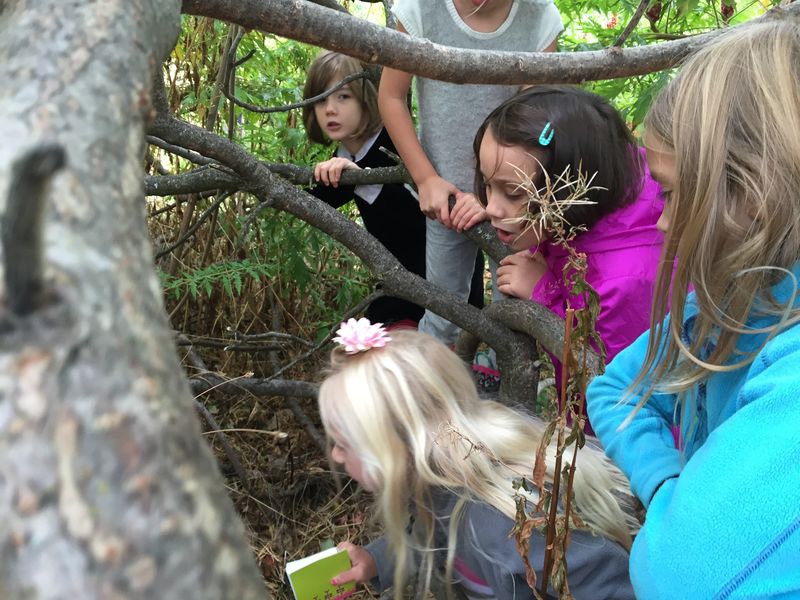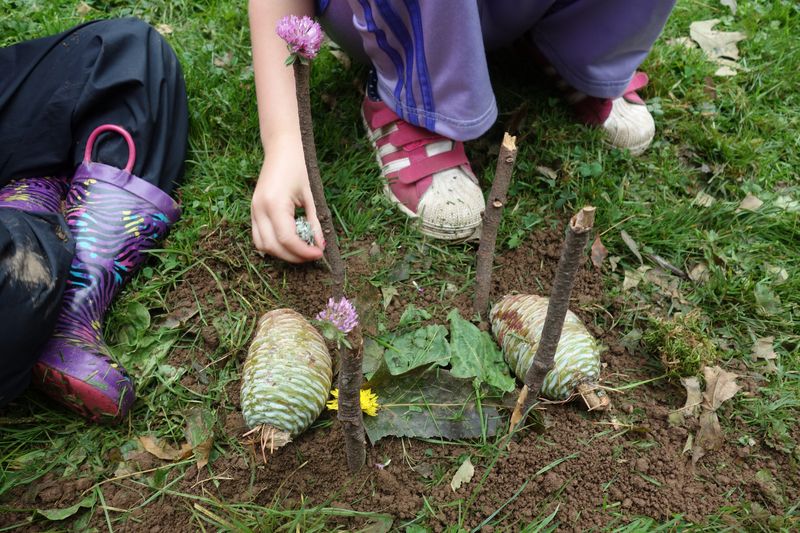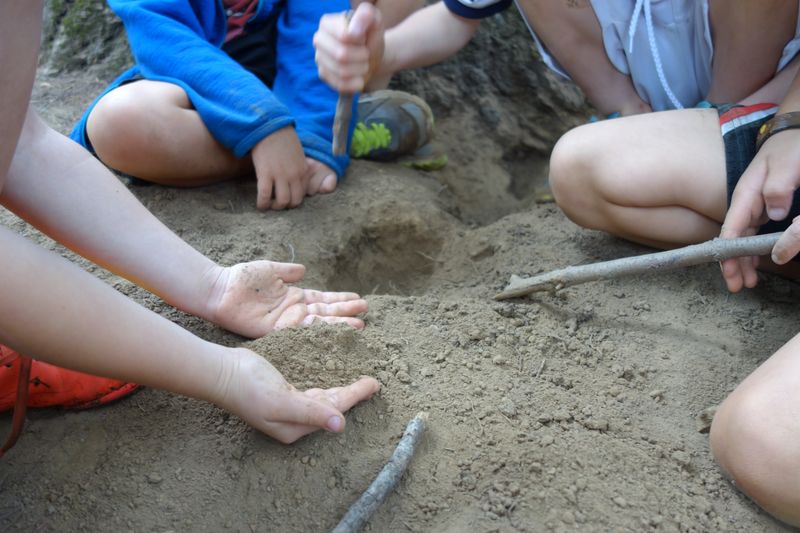Connection with the Natural World: Intentions as we start our year together

“If we want children to flourish, we need to give them time to connect with nature and love the Earth before we ask them to save it.” -David Sobel
In recent decades, research has examined and emphasized the importance of play within natural settings. Richard Louv, David Sobel, Cheryl Charles, Ann Pelo among other educators and thinkers have inspired the teacher-researchers at Opal School to consider the rights of children and the impact a relationship with the outdoors can have on the lives of children, the communities they thrive within, and their stewardship of the earth.
As teachers, we value that the natural world can afford children the space to make connections through play and we strive to nurture the connection children have with the outdoors. We believe these relationships support children to become mindful citizens who care about making contributions to their future and we are curious about uncovering how having ample time to play in nature might support children in ways we’ve yet to discover- if we listen.
At the start of the year, just a few short weeks ago we, a team of four primary teachers (K-2nd), set research questions that are offering us a lens through which to focus some of our intentions throughout the upcoming year. We wonder:
What is the reciprocal relationship between play, belonging and the natural world?
How will these relationships help us learn about ourselves and one another?
How might we invite children to reflect upon these relationships?
Interested in exploring these research questions even from the first days of school, we make sure to make ample time for children to spend time outdoors and bring their voices to the group. Before we started out on a hike, during the first week of school, we asked children why they believe it’s important that we go out outside at school:
ZB: You get to be active!
KN: It means like running around. It’s exercise.
KJ: It’s good to be outside. It’s good for nature to surround you…
AH: It is fun to play outside and you just want to go outside and sometimes your mom says yes and sometimes they say no!
MD: It’s important so that we can get fresh air and wake up our brains!
PW: And, it’s really, really, really fun!
On this particular hike, the Maple and Magnolia rooms visited Color Land, a favorite Hoyt Arboretum destination for many Opal students. Much of our time playing together in Color Land was spent among the crooked sumac and in the grassy field littered with smaller trees, stealthily chasing one another through and between trunks, squatting beneath and between limbs, and collecting traces of nature in pockets and in piles.
 When asking the children to reflect on how Color Land inspired their play, we first clarified the meaning of reflection:
When asking the children to reflect on how Color Land inspired their play, we first clarified the meaning of reflection:
TY: What is reflection?
LD: If you put a mirror up to the sun it will reflect the light.
SR: There’s another kind of reflection where you are looking back at what you did a few weeks ago or a long time ago or just earlier. You are thinking about the past.
And with that understanding, some children took turns describing Color Land and how its elements sparked their ideas for play:
ZB: Friends were there…they said I could join them.
RP: There were a lot of tiny little berries. They inspired me to play cooking. It’s a really fun place to play cooking games from stuff you collect from the ground.
OC: There’s cool sticks and it’s a good climbing place, a really good climbing place. It’s also a good place for hiding.
MW: I liked being a cat. I climb around in the branches.
AD: We were putting berries everywhere so the animals could have food for the winter.
Last week, in contrast to Color Land, we visited another place in the Arboretum. The Running Hill is known for its steep and grassy hill, its little Douglas fir forest, its many mole hills, and its fallen tree limbs. Here, the children shaped small worlds for insects, acted out chasing adventures, and found large sticks, marching with them atop their shoulders. We asked the children again about their play and what inspired them within the Running Hill. As we listened this time, we were surprised by some of what we heard:
OC- I like how the trees are so green and big. There’s so much running space. It’s free there!
OR- It’s where the air goes on you…when you run there. It’s the best place to run.
TY: Actually, my story inspired my play today. The Running Hill was a good space, because my story from Story Workshop was about camping and that inspired my play…. Squirrel, bunny and fox…
SM: Mischievous fox!
OC: When there’s a big space there can be a lot of games to play.
AV: I was building a fort but i didn’t finish it yet. I need big sticks…
EW: My Story Workshop story inspired me. I could probably only want to play that game in the Running Hill.
EP: Today I sort of woke up a new game… in the forest. I was making maps in Story Workshop and the maps I made inspired me to plan about what I was going to play outside.
SR: I found a really cool stick and used them as walking sticks and I dug with the stick.
LD: We made an underground fairy house by using a stick and digging with our hands.

At Opal we have come to expect that conversations and reflections such as this one are very likely to offer insight from the children’s perspective that we couldn’t have anticipated. We look forward to these surprises that children gift us with their thoughts and understanding of their experiences. If we have a practice of asking questions, listening with all our senses, and supporting ongoing dialog that welcomes all of their connections, these surprises will keep us curious and widen our lens of thinking, helping to guide our pace, decisions and the direction and cadence of our curriculum.
We heard children reflecting that their writing and ideas earlier in the day had hiked with them, in the form of maps and characters and games, and continued to grow in the different suitable spaces they found at the Running Hill. What they shared solicited more questions for us, as teacher-researchers, to consider:
How does the setting of the natural world influence the relationship between play and writing?
How then, is play a form of writing, and writing a form of play, and how can the children teach us about these relationships?
We wondered, would the children have continued to grow their stories from Story Workshop if we had been in a gymnasium?
…if we had gone to the playground instead?
…if we had chosen a different part of the arboretum to hike to?
…if we had just simply asked them to write more?
…if we had not had time to play outside at all?

“It is the play of our imagining that allows us to inhabit aspects of the world seemingly distant from ourselves.” –Richard Lewis
